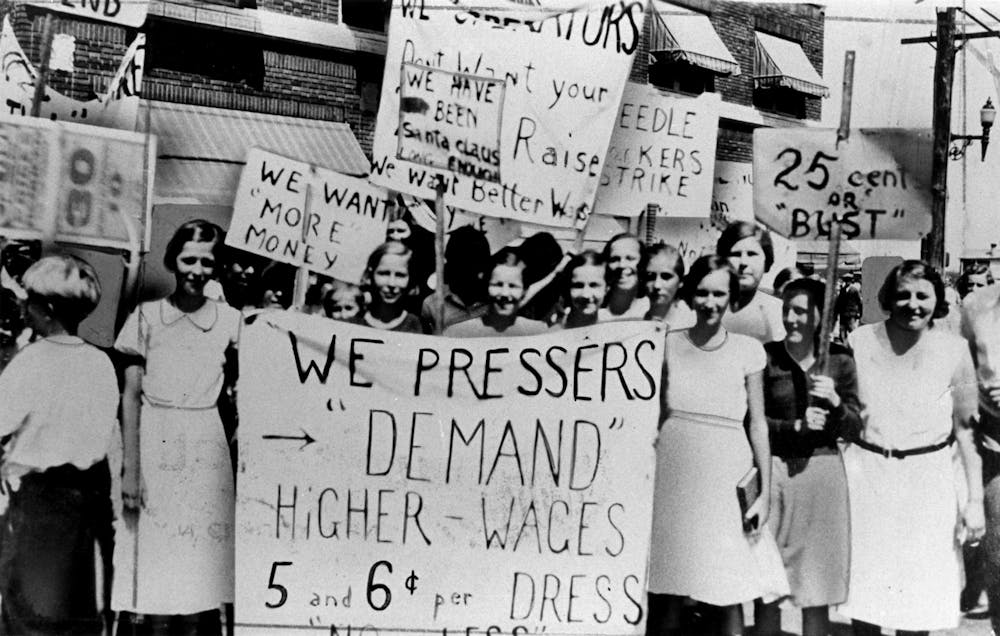This summer has seen Hollywood production come to a screeching halt after the Writers Guild of America (WGA) and Screen Actors Guild went on strike in May and July, respectively. Although these strikes may no longer be making the front page, Drew Barrymore has brought them back to the public’s attention this week. Barrymore announced (and later rescinded) plans to renew production on her weekday talk show after previously declaring her support for WGA.
Despite these long strikes effectively stopping production on the vast majority of films and television shows, they have not lost their momentum, continuing to draw support from fans and celebrities. Stars like Margot Robbie have picketed alongside union members and others have auctioned off objects and silly experiences to raise money to support crew members affected by loss of income.
Union strikes are far from contained to Hollywood. Just last week, the United Auto Workers (UAW) union went on strike against the “Big Three” automakers — General Motors, Ford and Stellantis — simultaneously for the first time in history. Auto workers are demanding increased wages, benefits and job security for members, after automakers have made record profits and CEOs have seen salary increases.
The UAW strike may align with the mental image many of us have when we think of strikes. The largest strikes in American history have been among blue-collar workers like miners, steel workers and railroad workers. However, unionization trends in recent years have given reason for us to update our definition of what a union is and to think beyond manufacturing and industrial jobs.
Apple store employees in Towson unionized in January, and the University of Pennsylvania’s medical residents and fellows unionized in May. These examples are two of many, illustrating a broader trend of unionization occurring in sectors that aren’t traditionally marked by union activity. The expansion of organization efforts and the emphasis placed on unions by President Joe Biden — who intends to be the “most pro-union president leading the most pro-union administration in American history” — are collectively forging a new era in American labor politics.
Unionization has increased nationwide in recent years. Between October 2021 and September 2022, the National Labor Relations Board saw a 53% increase in union election petitions, demonstrating that an increasing number of workers are interested in forming a union. The number of workers represented by a union increased to 16 million in 2022, up 200,000 from 2021.
These increases coincide with broad public support for unions, with 71% of Americans expressing approval of labor unions — the highest approval rating since 1965. Gen Z is the most pro-union generation, suggesting that the trend of unionization is here to stay.
The impacts of these national trends are also visible here at Hopkins. In January of this year, Hopkins graduate students overwhelmingly voted to unionize, following a nationwide trend of graduate student unionization on college campuses. The union, Teachers and Researchers United-United Electrical Workers, has advocated for guaranteeing graduate students a living wage, on-time payment and appropriate workplaces.
In addition, Hopkins dining workers are unionized, represented by UNITE HERE Local 7. Following the transition to self-operated dining last year, dining workers collectively bargained with the University regarding their new contract, job security and sick days.
Unionization is also on the verge of spreading to college athletics. In December 2022, the National Labor Relations Board in Los Angeles found merit in an unfair labor practice complaint filed on the behalf of the football and basketball teams at the University of Southern California.
The Board ruled that student-athletes should be considered employees of the university, creating the potential for student-athletes to exercise their rights as employees and unionize. Last week, the basketball team at Dartmouth College filed a petition to unionize and, if accepted, could be the first student-athlete union in the nation.
Although there are union success stories, it is an uphill battle. Employers have spent more than $400 million a year on union-busting efforts, hiring anti-union consultants who strategize to prevent union elections or sway workers to vote against the union. In 2022, more than 60 million workers indicated a desire to join a union but could not, demonstrating the continued challenges to unionization. Despite the obstacles, it is important that organizers and workers continue to persevere in their fight for employers to meet their demands.
Whether or not you are part of a union, unionization impacts you. As a consumer of Netflix, the writers and actors of your favorite shows going on strike affects you. As a student, your teaching assistant going on strike affects you. As someone who buys a daily coffee, your Starbucks baristas going on strike affects you. The minor inconveniences strikes may cause to our lives are nothing compared to the ongoing struggle for fair working conditions. As unions become increasingly more visible and widespread, it is important for all of us to be allies to their cause.





